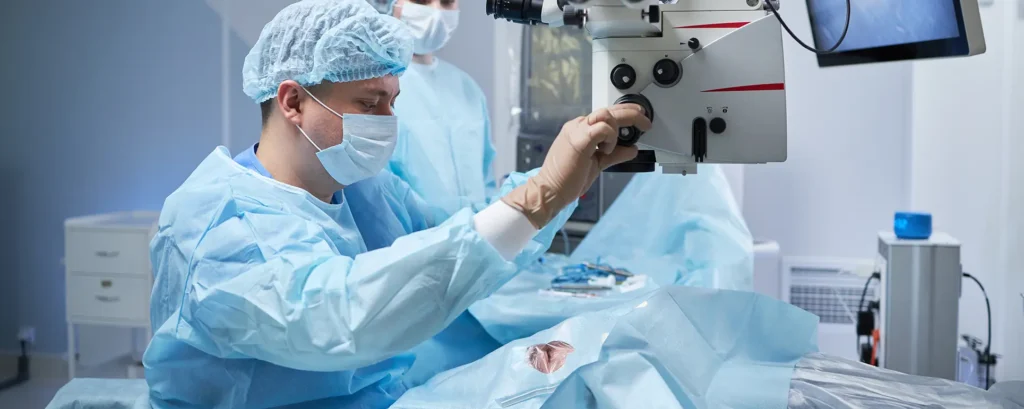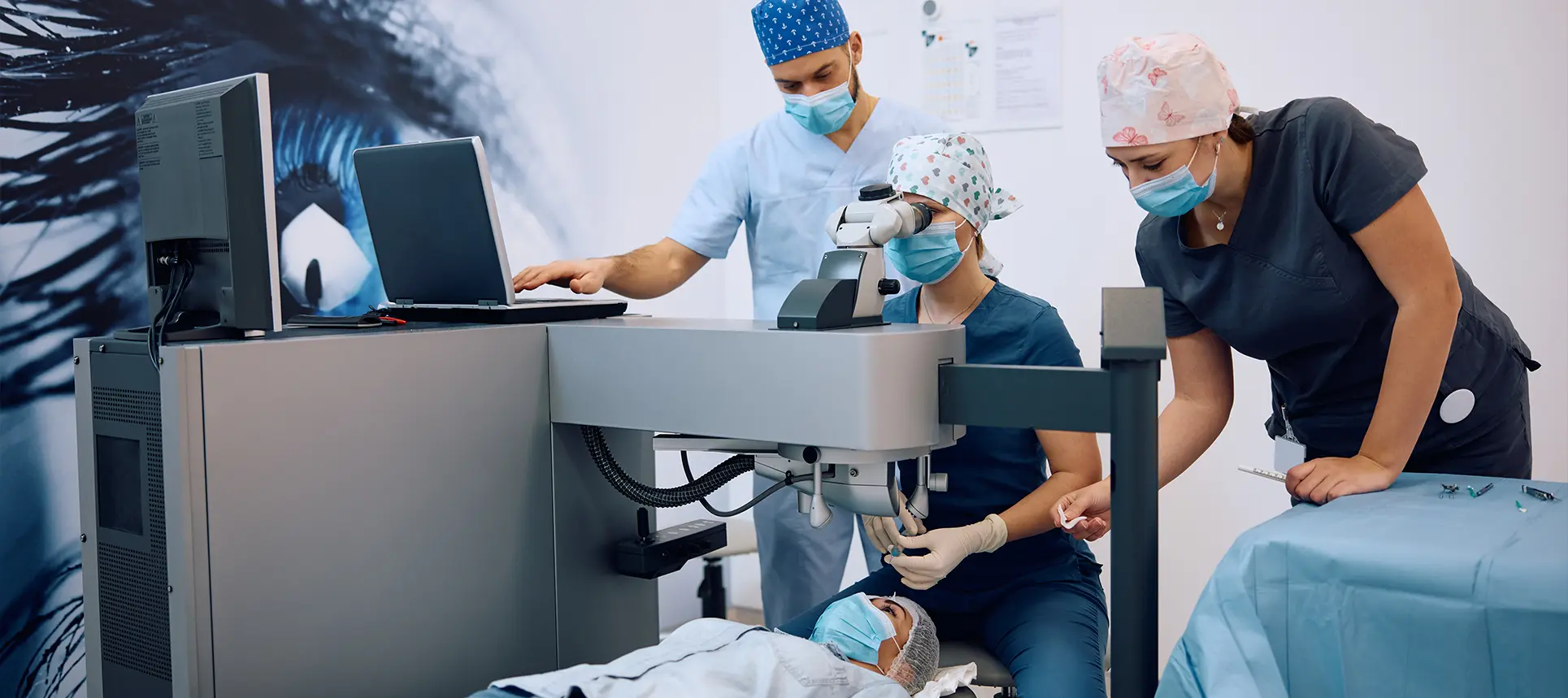If you’ve been told you have cataracts and you’re exploring treatment options, you’ve likely come across something called femtolaser cataract surgery. It might sound a bit high-tech—and it is—but that doesn’t mean it’s complicated. This guide will walk you through exactly what femtolaser cataract surgery involves, how it compares with other methods, who it’s suitable for, and what the experience is really like from start to finish. No jargon, no pressure—just clear, honest information to help you make an informed decision.
What Is Femtolaser Cataract Surgery?
Let’s start with the basics. Femtolaser cataract surgery—formally called femtosecond laser-assisted cataract surgery (FLACS)—is an advanced method that brings laser precision into the traditional cataract removal process. Instead of relying solely on handheld surgical instruments, this technique uses a highly focused laser to perform some of the most delicate parts of the operation. These include making the initial corneal incisions, creating a circular opening in the lens capsule (called a capsulotomy), and breaking apart the cloudy lens in preparation for removal.
The term “femtosecond” might sound technical, but it simply describes the speed at which the laser operates. A femtosecond is one quadrillionth of a second—so you can imagine just how fast and precise this technology is. Each pulse of the laser is incredibly controlled, allowing for pinpoint accuracy without applying any mechanical force to the eye. That means the surgeon can achieve highly consistent outcomes while potentially reducing the chance of certain complications that can arise with manual techniques.
One of the main appeals of femtolaser cataract surgery is that it replaces the blade with light. In traditional surgery, the initial incisions and the capsulotomy are made using fine surgical tools. With the femtosecond laser, these steps are guided by advanced imaging and performed without physically cutting the eye in the conventional sense. This shift to laser-guided incisions can lead to increased precision, especially in patients who require customised treatment due to complex eye shapes or additional visual needs.
It’s important to understand that femtolaser-assisted surgery doesn’t alter the ultimate aim of cataract treatment. Just like the conventional method, the goal remains to remove the eye’s natural lens that has become cloudy due to cataract formation and replace it with a clear artificial lens, known as an intraocular lens (IOL). Whether your surgeon uses a blade or a laser, the end result is the same: clearer vision and an improved quality of life.
What truly sets femtolaser surgery apart is the method of getting to that result. The process relies on real-time, high-resolution scans of the eye to guide each laser step, allowing your surgeon to tailor the surgery to your unique anatomy. This personalised approach can be especially beneficial if you’re considering premium IOLs, as it may aid in their alignment and placement. While both femtolaser and traditional techniques are highly effective, this modern laser-assisted method provides an alternative route to a well-established and successful procedure.
How Does Femtolaser Cataract Surgery Work?
Femtolaser cataract surgery is a step-by-step process that blends computer-guided imaging with laser precision. Here’s how it typically unfolds:
First, your eye is scanned using advanced imaging technology such as Optical Coherence Tomography (OCT). This produces a detailed, 3D map of your eye, helping your surgeon plan the surgery with tailored accuracy.
Next, the femtosecond laser is used to create the corneal incisions and open the lens capsule. It also pre-softens the cataract by breaking it into smaller fragments, which can make the next step—removal of the cloudy lens—smoother and gentler.

After that, the surgeon removes the lens fragments, just like in traditional phacoemulsification. An IOL is then implanted to restore your vision. The incision is usually self-sealing, meaning you won’t need stitches.
The result? A process that’s highly controlled and precisely executed. But again, this isn’t to say that traditional cataract surgery isn’t precise—both methods are safe and effective, and the right choice depends on your individual needs.
Benefits of Femtolaser-Assisted Cataract Surgery
One of the main draws of femtolaser cataract surgery is its level of precision. Because the laser is programmed using detailed images of your eye, it allows for very consistent incisions and capsule openings. This level of control can be particularly helpful in complex cases.
There’s also the potential for better IOL positioning. When the artificial lens is placed exactly where it should be, your visual outcomes may be more predictable—especially if you’re having a premium lens implanted, such as a toric or multifocal IOL.
Some patients also report that femtolaser surgery feels gentler, especially since the laser pre-softens the cataract before it’s removed. That means there may be less ultrasound energy needed during surgery, which in turn could reduce strain on the eye.
It’s worth remembering, though, that these benefits aren’t guaranteed—and they don’t necessarily mean femtolaser is “better.” It’s simply a different tool that may suit certain eyes or certain patients more than others.
Who Is a Good Candidate for Femtolaser Cataract Surgery?
Not everyone with cataracts will need or benefit from femtolaser-assisted surgery, but it may be considered in certain scenarios.
If you’re looking at premium intraocular lenses—like multifocal, toric, or extended depth of focus lenses—femtolaser can sometimes help with more precise placement and astigmatism correction, potentially giving you sharper vision without glasses.
Patients with dense cataracts or very shallow anterior chambers (the front part of the eye) might also be considered, since pre-softening the lens can make things smoother and potentially safer.
That said, this approach isn’t always suitable. Patients with certain corneal issues, advanced glaucoma, or small pupils may be better suited to traditional surgery. Your ophthalmologist will weigh up all these factors and help you understand what’s best for your eyes—not just based on technology, but on your overall eye health and lifestyle goals.
Is the Procedure Painful? What Should I Expect?
The thought of undergoing laser surgery on your eyes can understandably make some people feel anxious, especially if you’re not familiar with the process. But in reality, femtolaser cataract surgery is remarkably comfortable. You won’t be given a general anaesthetic—instead, your eye is numbed using local anaesthetic drops, which means you’ll be awake but won’t feel any pain. The drops take effect quickly and ensure the eye remains still and relaxed during the procedure.
While the laser is doing its work, you might notice a few odd sensations. Some patients report seeing bright lights or colourful patterns, almost like a light show. Others mention a brief feeling of pressure when certain parts of the procedure are taking place. These experiences are common and completely normal—and, more importantly, they’re not painful. The femtosecond laser part of the operation is extremely brief, often lasting less than a minute in total.

The full surgical process usually takes no more than 15 to 30 minutes per eye. Most of that time is spent on preparation and positioning rather than the laser itself. The team will explain each step as they go, so you’ll always know what’s happening. If you’re nervous, some clinics also offer mild sedation to help you feel more relaxed, but this is usually optional.
Once the surgery is finished, you’ll be given a protective eye shield to wear and some post-operative instructions. Your vision will likely be cloudy or fuzzy at first, which is entirely expected. Over the next few days, this should gradually clear up. You’ll also be prescribed anti-inflammatory and antibiotic eye drops to support healing and reduce the risk of infection. It’s important to follow your aftercare plan carefully to ensure the best possible recovery.
Recovery and Aftercare: What Happens Next?
The recovery process after femtolaser cataract surgery tends to be smooth for most patients, especially if you stick to the guidance provided by your surgical team. As soon as the procedure is complete, you’ll rest for a short time at the clinic before being discharged. You’ll need someone to accompany you and drive you home, as your vision will be temporarily blurred and your eye may feel slightly sensitive to light or wind.
During the first 24 to 48 hours, it’s normal to experience mild discomfort, such as grittiness, watering, or a foreign body sensation in the treated eye. Some people also notice halos around lights at night, which often settle as the eye heals. Your surgeon will usually schedule a follow-up appointment within a day or two to ensure the eye is healing properly and that there are no early signs of complications.
Over the course of the next week, you’ll notice your vision becoming clearer as your eye adjusts to the new intraocular lens. Many people are surprised at how quickly they can resume light activities such as reading, walking, or watching television. However, more physically demanding tasks—like heavy lifting, bending, or vigorous exercise—should be avoided for at least a couple of weeks to avoid putting pressure on the eye.
As part of your recovery, you’ll be instructed to continue using your prescribed eye drops for a few weeks. It’s also crucial to avoid rubbing your eyes, wearing eye makeup, or swimming during the initial recovery period. Most patients find their vision stabilises within four to six weeks, although this can vary depending on the type of lens implanted and whether you have other eye conditions. Regular follow-up visits will help your surgeon monitor progress and ensure that everything is on track.
Costs and Availability in the UK
In the UK, femtolaser cataract surgery is generally not available through the NHS. It’s considered a premium option and is mostly offered by private clinics. Prices can vary widely depending on the clinic, surgeon, and type of IOL used.
On average, you might expect to pay between £2,500 and £4,000 per eye, with some clinics charging more if you opt for advanced lenses. Many clinics offer finance plans or payment options, so it’s worth exploring what works best for you.

It’s also worth comparing what’s included in the cost—some packages cover follow-up care and enhancements, while others charge separately. Always ask for a full breakdown before you commit.
How Does It Compare to Traditional Cataract Surgery?
This is a common question—and the honest answer is that both approaches are very effective. Traditional cataract surgery, which uses a handheld blade for the initial steps, has been around for decades and continues to deliver excellent results for millions of people.
Femtolaser simply adds another layer of precision and customisation. In some cases, that may enhance the outcome, especially when used with premium lenses. In other cases, traditional surgery is perfectly sufficient and may even be preferred based on your eye’s anatomy.
Rather than asking which is better, it’s more helpful to ask which is best for you. This is a decision your consultant ophthalmologist will help you make, based on a detailed eye exam and a discussion about your expectations and lifestyle.
What Are the Risks and Potential Complications?
No surgery is without risks, but femtolaser cataract surgery is generally considered very safe. Complications are rare and usually minor when they do occur.
Possible issues include dry eyes, inflammation, swelling of the retina (known as cystoid macular oedema), or a temporary increase in eye pressure. These are typically short-lived and treatable with eye drops or additional care.
More serious complications, like infection (endophthalmitis) or retinal detachment, are extremely rare—especially in the hands of an experienced surgeon. Your pre-surgery consultation will include a thorough discussion of your risk factors, so you’re fully informed before making a decision.
Common Questions Patients Ask

Will I still need glasses after femtolaser surgery?
That depends on the type of lens you choose. Standard monofocal lenses usually require glasses for reading or distance, but premium lenses can reduce or even eliminate the need for glasses. Your surgeon will guide you through the options.
How soon can I fly or drive after the operation?
Most people can resume driving within a few days, provided their vision meets the legal standard. Flying is typically safe after a week, but you should always confirm with your surgeon.
Can both eyes be done at the same time?
Usually, cataract surgery is done one eye at a time, with a gap of at least a week between procedures. This allows the first eye to heal and ensures you’re comfortable before proceeding with the second.
What happens if I blink during the laser part of the surgery?
You don’t need to worry about blinking or moving your eye during the laser procedure. A special instrument gently holds your eyelids open, and your eye is kept stable using a suction ring. The laser only activates once everything is perfectly aligned, and the computer-guided system tracks even the tiniest movements in real time to maintain precision and safety.
Can I wear makeup after the surgery?
It’s best to avoid wearing eye makeup for at least one to two weeks after your procedure. Makeup particles can irritate the healing eye or introduce bacteria, increasing the risk of infection. If you use facial products or moisturisers, be cautious not to get anything near your eyes during this recovery period.
Will the artificial lens ever need replacing?
In most cases, no. The intraocular lens (IOL) implanted during cataract surgery is designed to last a lifetime. It won’t wear out or degrade, and it’s incredibly rare for it to need replacement. If vision changes occur in the future, it’s usually due to other age-related eye conditions or a common issue called posterior capsule opacification (PCO), which can be treated with a quick laser procedure—not by replacing the lens.
Final Thoughts
Femtolaser cataract surgery is a fascinating example of how far medical technology has come. It offers precision, consistency, and a degree of customisation that may appeal to some patients—especially those considering advanced lens options.
But that doesn’t make it the only way or necessarily the best way for everyone. Traditional cataract surgery remains a tried-and-tested method that delivers excellent outcomes for the vast majority of people.
Ultimately, the best approach is the one that fits your eyes, your goals, and your lifestyle. Talk to your ophthalmologist, weigh up the options together, and make the choice that feels right for you.
If you’d like to speak with an expert surgeon about your cataract surgery options—including whether femtolaser might be suitable for you—don’t hesitate to get in touch with us at London Cataract Centre. We’re here to help you see clearly again.
References
- Nagy, Z.Z., Takacs, A.I., Filkorn, T. and Sarayba, M., 2014. Complications of femtosecond laser-assisted cataract surgery. Journal of Cataract & Refractive Surgery, 40(1), pp.20–28. Available at: https://www.jcrsjournal.org/article/S0886-3350(13)01022-2/fulltext [Accessed 2 May 2025].
- Abell, R.G., Darian-Smith, E., Kan, J. and Allen, P.L., 2015. Femtosecond laser–assisted cataract surgery versus standard phacoemulsification cataract surgery: a systematic review and meta-analysis. American Journal of Ophthalmology, 160(1), pp.3–12.e1. https://doi.org/10.1016/j.ajo.2015.03.018
- Roberts, T.V., Lawless, M., Bali, S.J., Hodge, C. and Sutton, G., 2013. Surgical outcomes and safety of femtosecond laser cataract surgery: a prospective study of 1500 consecutive cases. Ophthalmology, 120(2), pp.227–233.
- Vasavada, A.R. and Raj, S.M., 2010. Cataract Surgery: Techniques, Complications and Management. 2nd ed. New Delhi: Jaypee Brothers Medical Publishers. [Print Book]
- Chee, S.P. and Yang, Y., 2016. Clinical outcomes in femtosecond laser-assisted cataract surgery: Efficiency, predictability, and safety. Asia-Pacific Journal of Ophthalmology, 5(2), pp.107–113.

